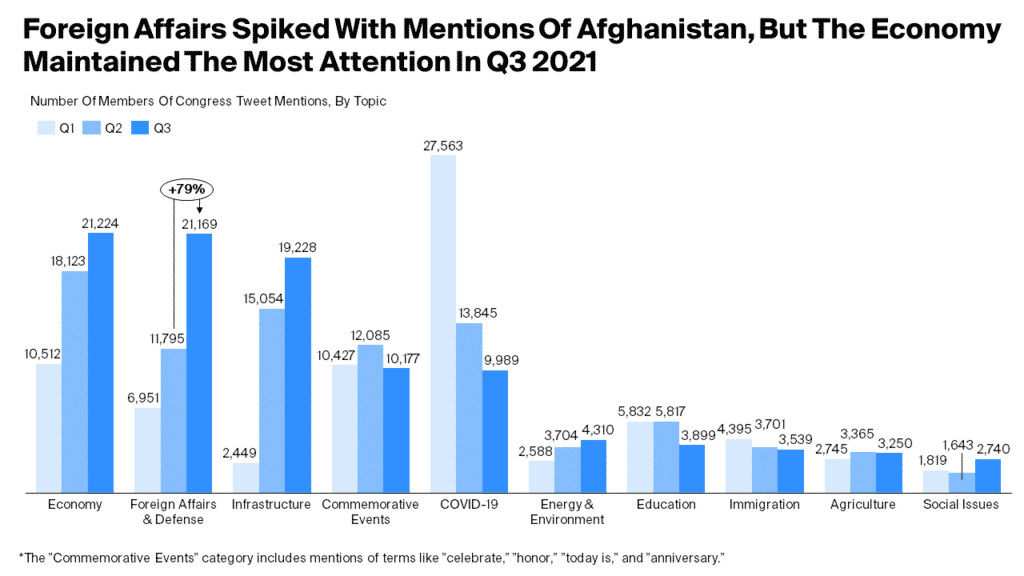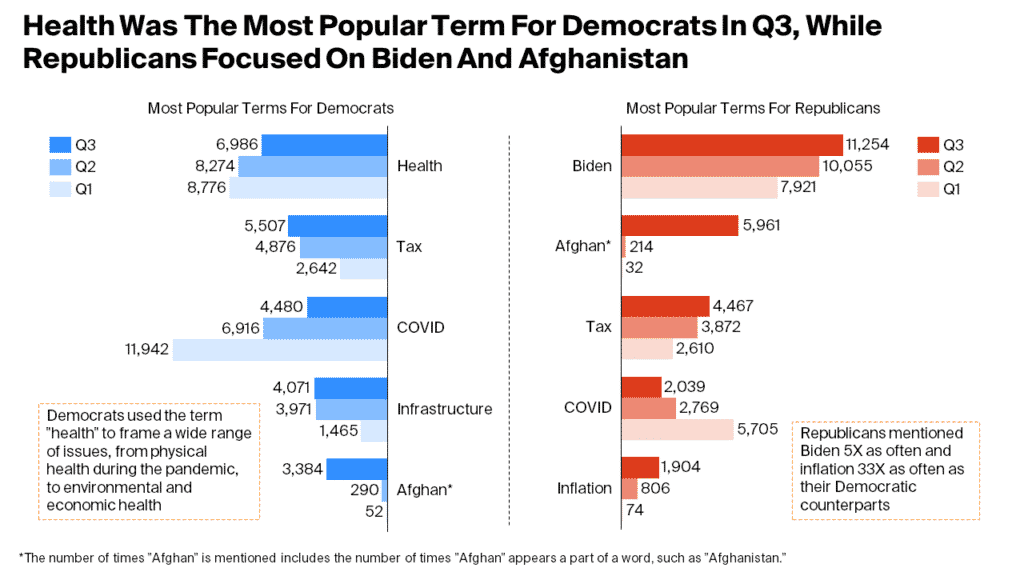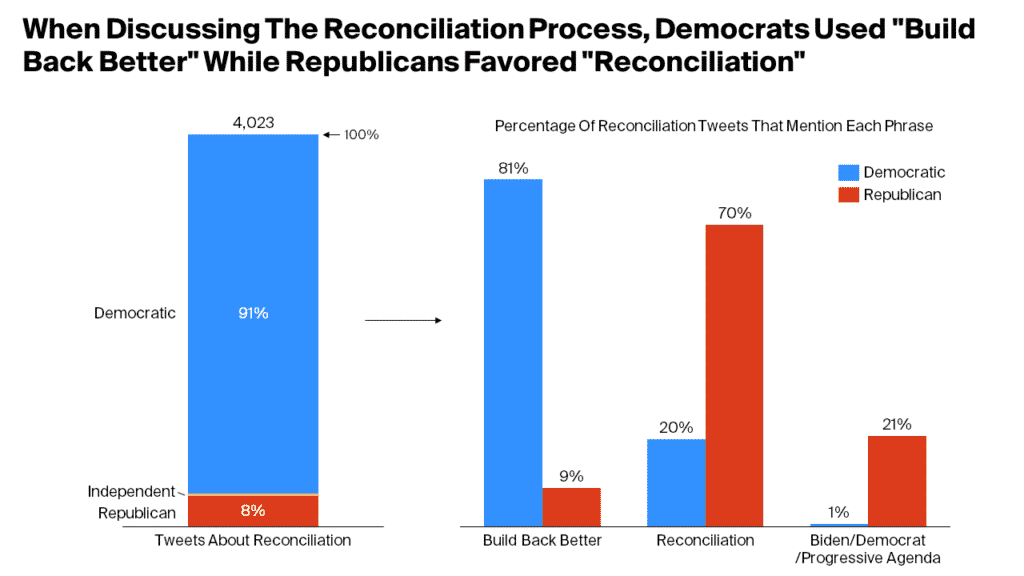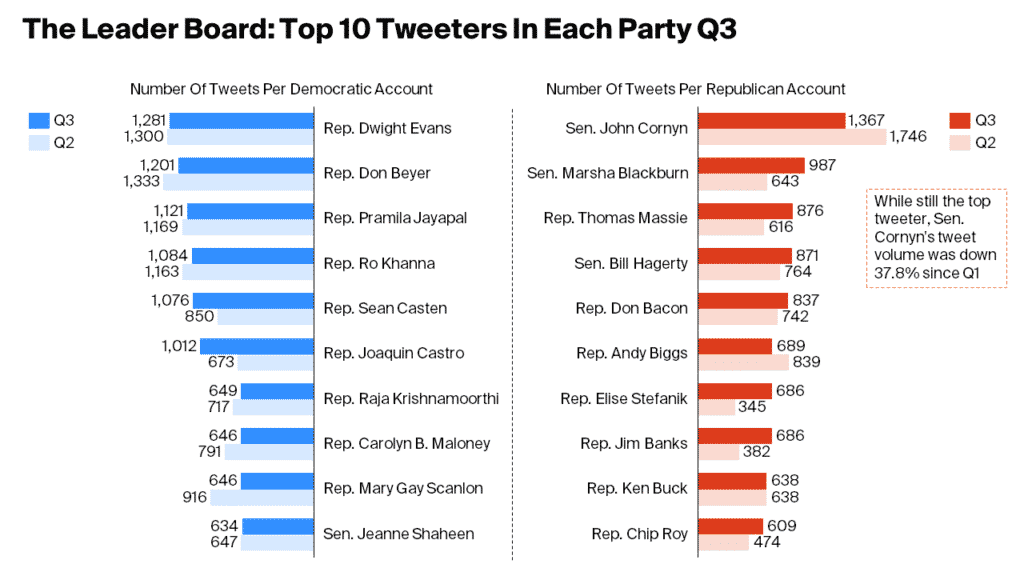Capitol Chatter: 2021 Q3 Analysis Of Congressional Tweets
Welcome back to Capitol Chatter: A Quarterly Analysis Of Congressional Tweets, where we help you keep track of what Congress is tweeting.
In the third quarter of 2021, congressional Twitter accounts sent out 130,293 tweets—a 10% decrease from the second quarter and a 17% drop from the first quarter. Members of Congress from both parties tweeted the most about President Biden’s agenda and the U.S.’ withdrawal from Afghanistan but diverged on their emphasis within each topic. Sen. John Cornyn (R-Texas) remained the most prolific tweeter, even though he tweeted 38% less in Q3 than he did in Q1. Read on for other findings.

The most notable difference between Q3 and the previous two quarters is the nearly 80% increase in the number of times members of Congress mentioned terms related to foreign affairs and defense. Driving the spike is the U.S. withdrawal from Afghanistan, which accounted for 9.6% of all tweets congressional Twitter accounts sent in Q3. The economy, however, remained the most-discussed topic in the third quarter. Debates over President Biden’s agenda spilled over from the Hill into cyberspace, causing continued increases in mentions of the economy and infrastructure.
Given the overall lower volume of tweets, Q3 saw slight, expected drops in many categories including commemorative events, education, immigration, and agriculture—all while the attention on COVID-19 continued to wane. By comparison, energy and environment maintained a rare upward trend both because of climate- and energy-related components of President Biden’s agenda and international climate milestones, namely the publication of the UN Intergovernmental Panel on Climate Change’s Sixth Assessment Report (IPCC AR6) and the upcoming UN Climate Change Conference (COP26).
Social issues surpassed racial equity as the 10th most mentioned topic in Q3. Members of Congress from both parties tweeted about the topic at comparable levels (Democrats about 1,450 times and Republicans just shy of 1,300 times). Republicans were most vocal around mid-July, when a House subcommittee approved a Department of Health and Human Services funding bill without the Hyde Amendment, which had prohibited the use of federal Medicaid to cover almost all abortions. Democrats tweeted the most about social issues after the Texas law (SB 8) banning almost all abortions in the state after about six weeks of pregnancy went into effect in September.

Term-by-term breakdowns illustrate the different ways in which the two parties discussed topics of common interest. In tweets about the economy, for example, Democrats often discussed the “health” of the economy, while inflation was a major topic for Republicans. In the parties’ respective mentions of tax in Q3, Democrats tweeted about raising taxes on wealthy individuals and corporations, provisions in the Build Back Better Act, while Republicans tweeted their opposition. As Democrats continue to push President Biden’s infrastructure investment proposal through the legislative process, infrastructure rose to one of the most mentioned words in Q3. Democrats made up 65% of these mentions, yet on August 10, the day the bipartisan infrastructure bill passed the Senate, Democrats and Republicans mentioned infrastructure equally frequently.
Republican members of Congress were responsible for nearly two-thirds of tweets about Afghanistan and focused more on the economic and strategic ramifications of the withdrawal, including U.S. strategic interest in the region vis-a-vis Russia or China. Meanwhile, their Democratic counterparts focused more on immigration in light of the influx of Afghan refugees.

The difference between the Democratic and Republican messaging on the reconciliation process is evident in tweets that are regularly consumed by constituents, members of the media, and Beltway stakeholders. Democrats not only contributed to over 90% of tweets about the reconciliation bill, but they also overwhelmingly referred to President Biden’s budget proposal under consideration by its name, “Build Back Better.” By contrast, most Republicans referred to the ongoing negotiations on the Hill as “reconciliation,” a more technical, less-widely-understood term that gives off the impression of a bureaucratic process.

The reigning leader board champion Sen. John Cornyn (R-Texas) remained the most prolific tweeter in Q3, even though his overall volume of tweets dropped 22% from Q2 to Q3 and nearly 38% from Q1 to Q3. The rest of the list saw some shuffling from Q2 to Q3. The Democratic side saw a senator, Sen. Jeanne Shaheen (D-N.H.), rise into the top 10 for the first time since the beginning of 2021; Representatives Lloyd Doggett (D-Texas), Mark Pocan (D-Wis.), and Val Demings (D-Fla.) dropped out of the list, having been replaced by Q1 top-ten tweeter Rep. Raja Krishnamoorthi (D-Ill.) and Rep. Joaquin Castro (D-Texas).
The Republican leader board for the first time became predominantly House members, as Reps. Thomas Massie (R-Ky.), Elise Stefanik (R-N.Y.), Jim Banks (R-Ind.), and Chip Roy (R-Texas) surpassed Sens. Ted Cruz (R-Texas), Rob Portman (R-Ohio), Rick Scott (R-Fla.), and Minority Leader Kevin McCarthy (R-Calif.) as the most frequent tweeters. The difference between these top tweeters from the rest of the members of their respective parties are considerable: on average, top 10 Democratic tweeters posted 935 tweets in Q3, while the rest of Democratic members tweeted fewer than 250 times; top 10 Republican tweeters posted 824 times in Q3, whereas the average for the rest of the GOP is 185 times.
Methodology
HPS conducted text analysis on all tweets and retweets from handles included in CSPAN’s “members of Congress” Twitter list that were posted between July 1, 2021 and September 30, 2021. In total, we searched for more than 150 keywords in each of the 130,293 tweets to determine which topics were discussed in each.